Managing a growing partnership marketing program can feel overwhelming, especially when your systems don’t communicate with each other. Juggling different tools, trying to sync data manually, and ensuring everything is up-to-date can feel like a constant struggle.
Thankfully, REST APIs are a ready-to-go solution. By connecting your software and automating data exchange, REST APIs eliminate the headaches of managing disjointed systems.
In this blog, you’ll learn how REST APIs can benefit partnership marketing programs and how to start with existing impact.com APIs.
The key role of REST APIs in partnership marketing
REST APIs serve as the bridge between platforms in your partnership marketing tech stack, enabling seamless communication. An API (application programming interface) is a set of rules allowing different software applications to interact. REST (representational state transfer) APIs, a specific type of API, use standard HTTP methods for enhanced scalability and flexibility.
These characteristics make REST APIs ideal for partnership marketing. They facilitate easy integration of multiple platforms and handle large volumes of data and complex workflows efficiently. By leveraging REST APIs, you can create a more interconnected and robust marketing ecosystem.
How can REST APIs benefit partnership marketing?
REST APIs have several key benefits for marketers collaborating with partners, from automating data transfer across multiple platforms to reducing dependence on developers.
Share data across all your platforms and tools
These APIs make it easier to sync data, including leads or customer interactions, between your systems and your partners. Real-time data flow makes it easier to collaborate with partners and stakeholders. When all your tools integrate correctly, it’s easier to improve the efficiency of joint marketing efforts.
Scale up your partnership programs
As your partnership network grows, so will the amount of data you need to manage. Whether adding new partners, expanding your campaigns, or integrating additional tools, REST APIs allow you to scale your operations without compromising performance so that all partners can access and share data effectively as volumes increase.
Rely on a cost-effective solution
Usually, you can use your existing web tech and reduce development costs.
Keeping the cost under control is key for partnership marketing––you may want to allocate large budgets across multiple partners and campaigns. By reducing integration costs, REST APIs make it easier for businesses of all sizes to maximize their partnership marketing.
Take advantage of a flexible solution
REST APIs are versatile and work with various data formats (like JSON and XML) and different request types, such as GET and POST.
The flexible nature of REST APIs lets you tailor your partnership marketing strategies to suit different platforms or partner needs. For instance, you can customize data exchanges based on specific partner requirements, ensuring that the integration supports each partnership’s unique goals.
REST APIs facilitate data integration
REST APIs provide a standardized way of accessing and exchanging data, enabling partners to communicate with each other using different tools and software.
Constant communication ensures all parties can access the most up-to-date information and eliminates complex manual data transfers. Ultimately, APIs streamline the integration process so partners can focus on collaboration and campaign success rather than technical hurdles.
How to use REST APIs for partnership success: 4 examples of popular integrations on impact.com
It’s easy to get started with impact.com’s API––all you need to do is log into the impact.com developer portal.
From the developer portal, it’s easy to integrate impact.com with your favorite tools found in the partner directory. When you use impact.com, you can tap into open APIs and a full library of 150+ pre-built connectors.
Here are four popular platforms you may want to integrate with impact.com:
HubSpot keeps track of marketing leads
With impact.com’s integration with HubSpot, you can track which partners bring in new customers through unique tracking links. When these customers take a new action, like an upgrade or renewal, it automatically ties back to the referral partner.
The integration also monitors leads as they move through the sales funnel in HubSpot, with all activity reflected in impact.com reports. Partners receive compensation automatically when leads reach the desired funnel stage, ensuring accurate and timely payments.
How to integrate impact.com and HubSpot
To get started, navigate to the Connector website.
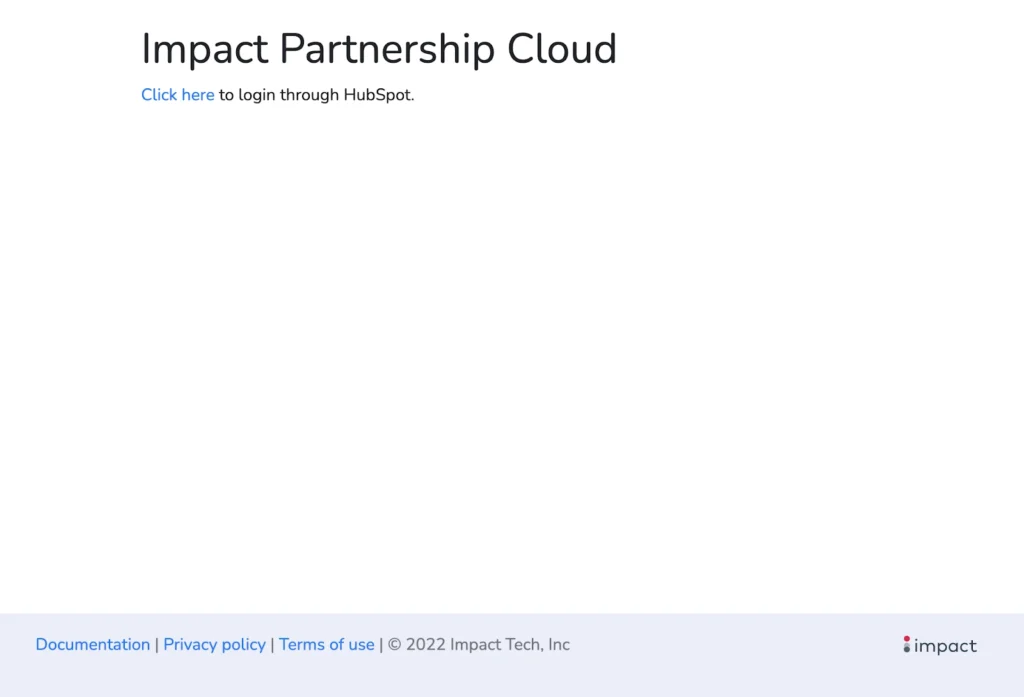
Select Click here to login through HubSpot, then log in with your HubSpot credentials.

From here, follow the rest of the prompts to connect your impact.com account.
Shopify gathers data from ecommerce sales
Using impact.com’s integration with Shopify lets you quickly set up and automate your affiliate and influencer programs without needing developer work. Get up and running within minutes!
Within the impact.com platform, you can easily discover and recruit new partners, automate contracts and payments, and track performance—all within a single platform. The integration streamlines the process so merchants can scale their revenue and acquire new customers as partners promote their products. The integration requires no development work, so you can get your program up and running quickly.
Plus, it includes features like automatic commission reversal for returned orders, which saves time and money and ensures payments are made only when partners deliver results.
How to integrate impact.com and Shopify
To get started, login to Shopify and visit the impact.com Affiliate Marketing app in the Shopify App Store, then select Install.
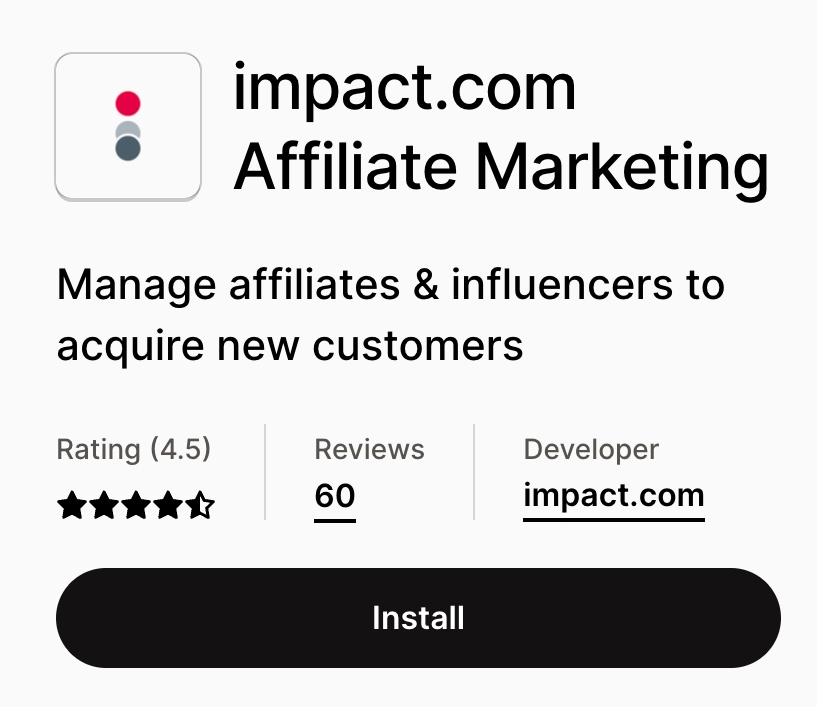
Shopify will prompt you to install Impact: Partnership Cloud. Review the details on the screen and select Install App.
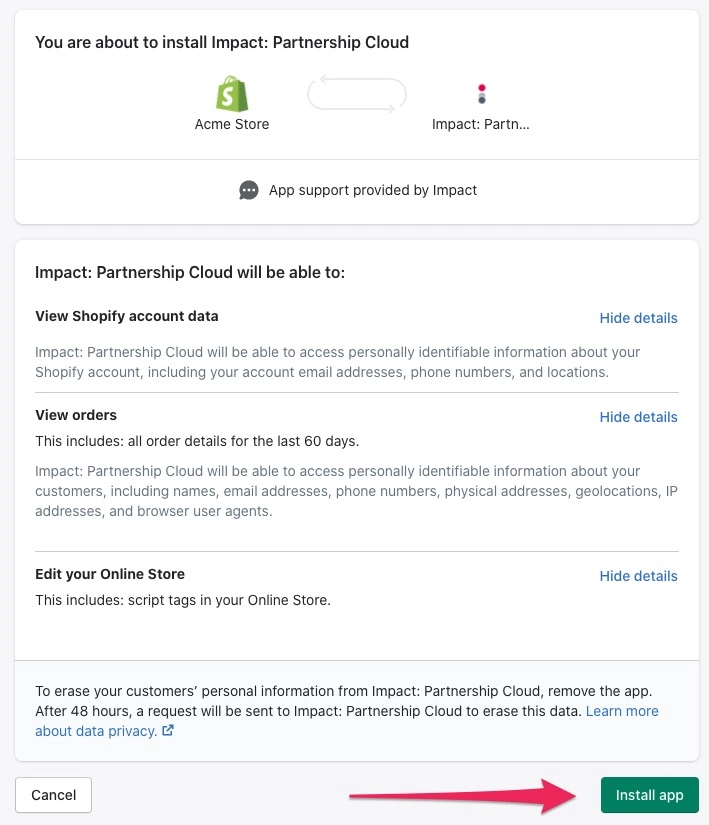
Once installed, find the app in your list of Shopify apps. To begin, select Set up your integration.
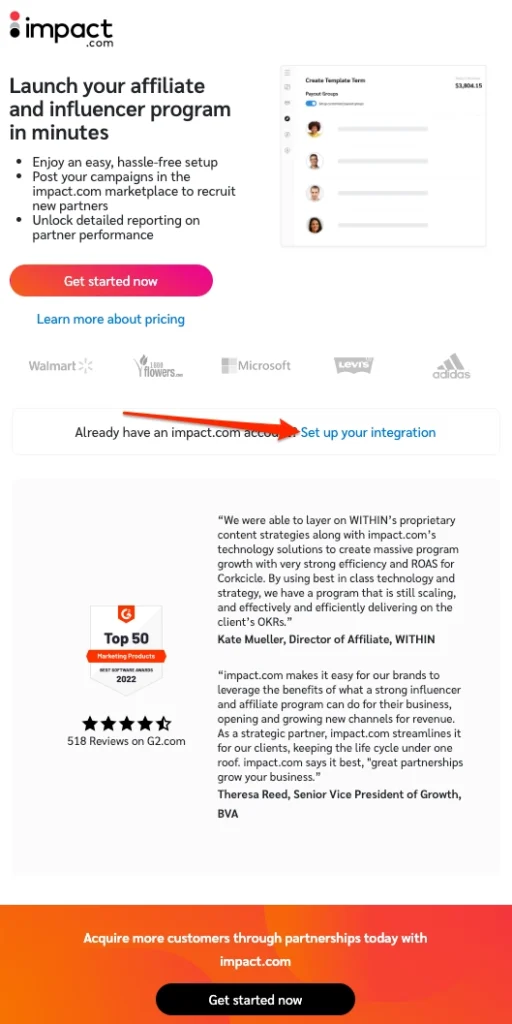
- Select a tab to view the next set-up steps for your impact.com program
- Under the Account Settings tab, input your impact.com account settings.
- Next, fill in the details for either the Affiliate, Creator or Advocate settings according to which account you have with impact.com.
- Select Save. You’ll see a confirmation screen for the enabled integration and your impact.com account information.
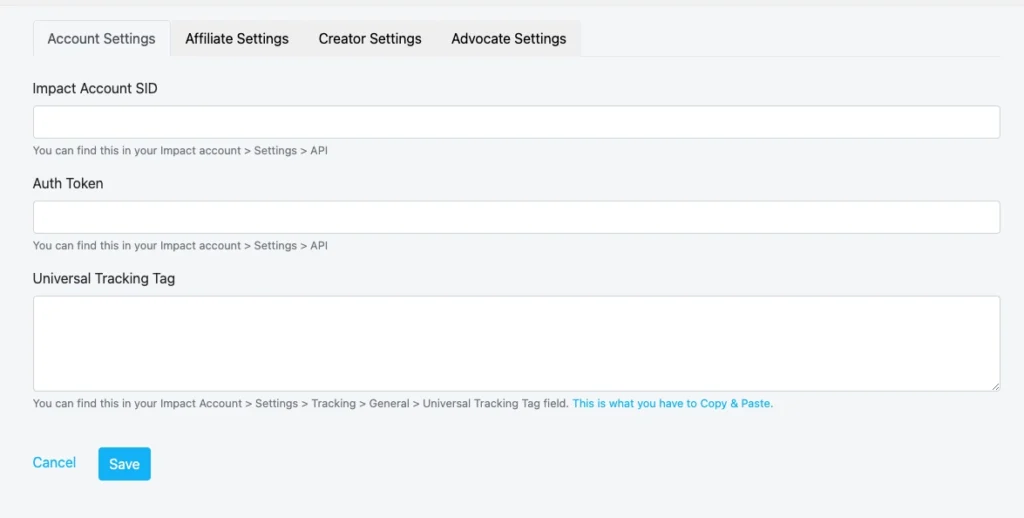
Salesforce tracks sales conversions from partnerships
You can use the Salesforce and impact.com integration to track conversions, such as sales leads and business opportunities. Flexible mapping allows you to define conditions that trigger a conversion.
Then, you can pay partners accordingly using impact.com’s contracting and commissioning features. Unique tracking links highlight which partners drive new customers, with actions such as upgrades or renewals automatically linked back to the referral partner. As leads progress through the sales funnel, impact.com’s reporting tracks all activity and pays partners on time and accurately.
How to integrate impact.com and Salesforce
To integrate with Salesforce, go to the impact.com Partner Manager page on the Salesforce AppExchange page.
- Select Get It Now.
- Follow the on-screen instructions to install the impact.com app.
- Open the app and follow the prompts to connect your impact.com account.
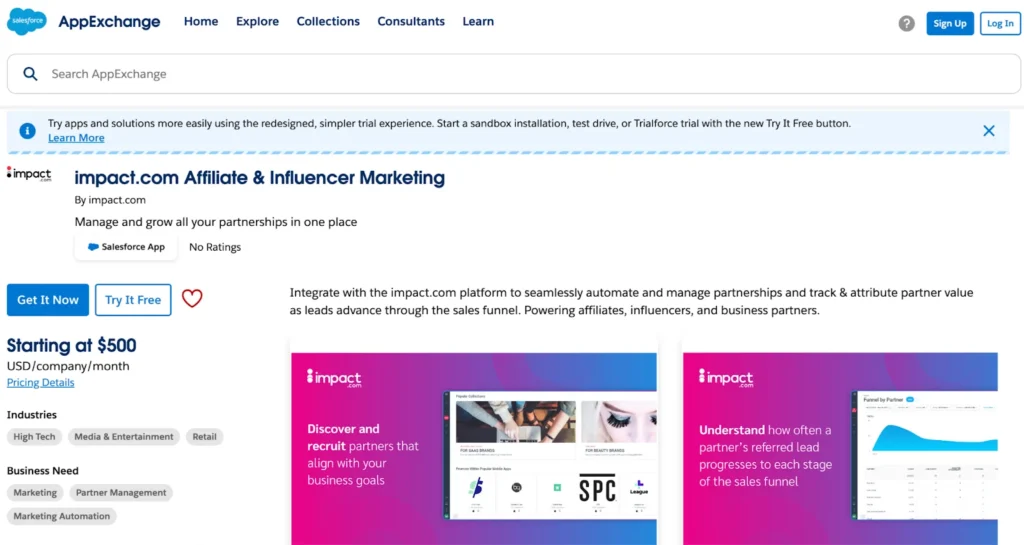
Next, go to your Salesforce account and navigate to the Impact Setup tab.
- In the tab, input the required fields and select ‘Save’
- Next, fill in the other tabs. For more information on this, check out this page.

Simplify your partnership data integration with REST APIs
REST APIs are powerful tools that simplify managing partnerships by enabling seamless integrations, efficient data sharing, and automated processes. By using impact.com’s REST APIs, you can enhance your partnership program, making it more scalable, flexible, and effective.
Whether tracking performance, automating payments, or integrating with various platforms, REST APIs streamline the entire process. This allows you to focus on growing and optimizing your partnerships without getting bogged down by technical complexities.
Want to find out more about impact.com’s integrations? Check out these resources:
- Get more efficient and grow your business with Impact APIs [blog]
- How to get started with the impact.com + HubSpot integration [ebook guide]
- Drive partnership growth with the Klaviyo and impact.com integration [one sheet]
- impact.com integrations guide [guide]
FAQs
An API (application programming interface) is a set of rules that allows different software applications to communicate with each other. A REST API is a specific type of API that follows the principles of REST (representational state transfer). It uses standard HTTP methods and is designed for scalability, simplicity, and statelessness. All REST APIs are APIs, but not all APIs are REST APIs.
An example of a REST API is the impact.com API. It allows users to manage their partnership programs by enabling automated tasks such as creating and updating partner contracts, tracking performance, and processing payments.
Using standard HTTP methods, the impact.com API provides a simple and scalable way to integrate impact.com with your existing tech stack without manual intervention.
REST APIs improve data integration by creating a standardized communication method between systems, enabling seamless real-time data exchange. They reduce manual processes, making integration more efficient, accurate, and scalable across various platforms and tools.






